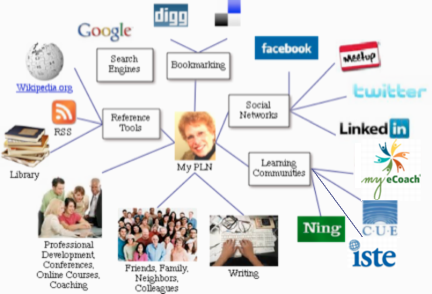Learning can happen anywhere at anytime from anyone and anything. Your connections and any information you use are learning experiences that can help you grow personally and professionally. I wrote this article for CUE in 2009 and felt it was appropriate to update it for the ISTE 2011 Conference in 2011. I’ll be there — very busy but learning so much from the people in my PLN.
Personal Learning Network (PLN)
There is nothing new about PLNs. They are the people and information sources that help you meet your learning goals. Building your PLN means that you not only seek to learn from others but you also help others in the network learn. Anyone can make a contribution. Your PLN can be your most powerful learning tool no matter what the subject. My PLN used to be the people I met face-to-face: the people I worked with, classes I took or taught, friends and family, organizations I joined and the information was what I googled on the Internet, in books, textbooks, or periodicals at the library. Remember how long it used to take to find what you were looking for?
Now my PLN connects me to others and to information in ways I never thought possible a few years ago. I still use Google to search for information but now I can find trends, maps, and even literature reviews. Social networks connect me to friends, work contacts, and friends of friends. I can see what they are doing in Twitter, updates on their conversations and links to new information. Facebook not only updates the status of each of my connections, I can join groups set up by friends and learn from wall posts. Here’s a diagram of some of my PLN:
Use a mindmapping program such as Inspiration or Mindmeister to diagram your own PLN.
So how can your PLN help you build your Professional Learning Community (PLC)?
Your PLN can help you meet your personal and/or professional learning goals. A PLC is where you focus on student learning. Your PLC focuses on a specific problem area of the students in your school. Richard DuFour shares three critical questions that drive the work of the PLC:
- What do we want each student to learn?
- How will we know when each student has learned it?
- How will we respond when a student experiences difficulty in learning?
We know a teacher can make a difference to the children in their classroom. However, a school may find many of the children in the entire school are falling through the cracks. The teachers in the school as a PLC can collaborate to improve or restructure how they reach at-risk students. They can analyze student data reviewing patterns and trends. Each teacher can use their PLN to research background information about specific issues brought to light from the data analysis, to ask questions of others in similar situations, to connect with other classrooms for global collaborations, and to share the findings from their PLC.
The PLC becomes a Community of Practice (CoP)
The CoP is where you take what you learned in the PLC and transfer it to practice where teachers can work together to do action research and/or lesson study. The teacher can ask “What does it take for me to change my practice to include this new learning?” This is deep, thoughtful work involving modeling new methodologies, observations from another teacher or coach, reflections on the results and process by asking what worked, what didn’t work.
Your PLN connects you to other professionals and to the information that will help you with your work in your PLC and CoP. Not only will the PLN help you, you can use your PLN to share best practices, blog reflections, and post examples of student work.




[…] background-position: 50% 0px ; background-color:#222222; background-repeat : no-repeat; } barbarabray.net – Today, 8:53 […]
[…] https://barbarabray.net/2011/06/23/your-pln-helps-your-plc-become-a-cop/ […]
[…] Barbara Bray estime qu'il est aisé de transformer son EPA (Environnement personnel d'apprentissage) en Réseau personnel d'apprentissage, puis en communauté d'apprentissage professionnel et enfin en communauté de pratiques. L'apprentissage est clairement et essentiellement social. L'EPA n'est valable que s'il facilite le partage des problématiques et des réflexions, puis l'action commune. B. Bray considère la communauté de pratiques comme la forme la plus élaborée d'action collective, celle qui témoigne de processus d'apprentissage et de coordination matures, susceptibles d'être modélisés, analysés, avant d'alimenter à leur tour les environnements et réseaux d'apprentissage des membres d'une communauté élargie. […]
[…] Aquí os dejo con una publicación muy interesante de Barbara Bray sobre el PLN y dos otros conceptos: PLC y CoP https://barbarabray.net/2011/06/23/your-pln-helps-your-plc-become-a-cop/ […]